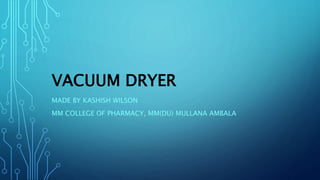Vacuum dryer
•Transferir como PPTX, PDF•
0 gostou•159 visualizações
PHARMACEUTICAL ENGINEERING
Denunciar
Compartilhar
Denunciar
Compartilhar

Recomendados
Recomendados
Mais conteúdo relacionado
Mais procurados
Mais procurados (20)
CENTRIFUGATION EQUIPMENT, PERFORATED BASKET CENTRIFUGE

CENTRIFUGATION EQUIPMENT, PERFORATED BASKET CENTRIFUGE
Pharmaceutical Engineering: Material of pharmaceutical plant construction

Pharmaceutical Engineering: Material of pharmaceutical plant construction
Semelhante a Vacuum dryer
Semelhante a Vacuum dryer (20)
Mais de KashishWilson1
Mais de KashishWilson1 (20)
Último
God is a creative God Gen 1:1. All that He created was “good”, could also be translated “beautiful”. God created man in His own image Gen 1:27. Maths helps us discover the beauty that God has created in His world and, in turn, create beautiful designs to serve and enrich the lives of others.
Explore beautiful and ugly buildings. Mathematics helps us create beautiful d...

Explore beautiful and ugly buildings. Mathematics helps us create beautiful d...christianmathematics
https://app.box.com/s/7hlvjxjalkrik7fb082xx3jk7xd7liz3TỔNG ÔN TẬP THI VÀO LỚP 10 MÔN TIẾNG ANH NĂM HỌC 2023 - 2024 CÓ ĐÁP ÁN (NGỮ Â...

TỔNG ÔN TẬP THI VÀO LỚP 10 MÔN TIẾNG ANH NĂM HỌC 2023 - 2024 CÓ ĐÁP ÁN (NGỮ Â...Nguyen Thanh Tu Collection
Último (20)
Explore beautiful and ugly buildings. Mathematics helps us create beautiful d...

Explore beautiful and ugly buildings. Mathematics helps us create beautiful d...
Kodo Millet PPT made by Ghanshyam bairwa college of Agriculture kumher bhara...

Kodo Millet PPT made by Ghanshyam bairwa college of Agriculture kumher bhara...
This PowerPoint helps students to consider the concept of infinity.

This PowerPoint helps students to consider the concept of infinity.
Food safety_Challenges food safety laboratories_.pdf

Food safety_Challenges food safety laboratories_.pdf
Salient Features of India constitution especially power and functions

Salient Features of India constitution especially power and functions
Basic Civil Engineering first year Notes- Chapter 4 Building.pptx

Basic Civil Engineering first year Notes- Chapter 4 Building.pptx
Micro-Scholarship, What it is, How can it help me.pdf

Micro-Scholarship, What it is, How can it help me.pdf
HMCS Max Bernays Pre-Deployment Brief (May 2024).pptx

HMCS Max Bernays Pre-Deployment Brief (May 2024).pptx
On National Teacher Day, meet the 2024-25 Kenan Fellows

On National Teacher Day, meet the 2024-25 Kenan Fellows
TỔNG ÔN TẬP THI VÀO LỚP 10 MÔN TIẾNG ANH NĂM HỌC 2023 - 2024 CÓ ĐÁP ÁN (NGỮ Â...

TỔNG ÔN TẬP THI VÀO LỚP 10 MÔN TIẾNG ANH NĂM HỌC 2023 - 2024 CÓ ĐÁP ÁN (NGỮ Â...
Vishram Singh - Textbook of Anatomy Upper Limb and Thorax.. Volume 1 (1).pdf

Vishram Singh - Textbook of Anatomy Upper Limb and Thorax.. Volume 1 (1).pdf
Vacuum dryer
- 1. VACUUM DRYER MADE BY KASHISH WILSON MM COLLEGE OF PHARMACY, MM(DU) MULLANA AMBALA
- 2. PRINCIPLE... • Vacuum drying is generally used for the drying of substances which are hygroscopic and heat sensitive, and is based on the principle of creating a vacuum to decrease the chamber pressure below the vapour pressure of the water, causing it to boil. Hence, water evaporates faster. The heat transfer becomes, i.e., rate of drying enhances substantially
- 4. CONTINUE.... • The oven is divided into hollow trays which increases the surface area for heat conduction. • The oven door is locked air tight and is connected to vacuum pump to reduce the pressure. • The materials to be dried are kept on the trays inside the vacuum dryer and pressure is • reduced by means of vacuum pump. • The enclosed space ( aproximately 1.5 meter cube ) is devided in to a number of portions by means of 20 hollow shelves, which are part of the jacket. These shelves provide larger surface area ( about 45 to 50 meter square ) for conduction of heat. Over the shelves, metal trays are placed for keeping the material. The oven door can be locked tightly to give an air tight seal. The oven is connected to a vacuum pump by placing condenser in between.
- 5. WORKING... • The tray that are present in the dryer are used to dry the material that are placed in the shelves and the pressure is reduced to 30 to 60 Kps by vacuum pump. • The door closes firmly and steam passes through the jacket space and the shelves. So the heat transfer is carried out by the conduction mechanism. • When evaporating under vacuum, the water is evaporated from the material at 25 – 30℃. The vapour goes to the condenser. After drying vacuum line is disconnected. Then the materials are collected from the tray
- 6. ADVANTAGES... • Material handling is easy. • Hollow shelves which are electrically heated can be used. • It provides large surface area. So the heat can be easily transfer through the body ofthe dryer and last drying action takes place. • Hot water can be supplied through the dryer, which help in drying process at the desired temperature
- 7. DISADVANTAGES.... • Dryer is a batch type process. • It has low efficiency. • It is more expensive. • Labour cost is too high. • Needs high maintenance. • There is a danger of overheating due to vacuum.
- 9. PHARMACEUTICAL USES • Heat sensitive materials, which undergo decomposition. • Dusty and hygroscopic material. • Drugs containing toxic solvents. These can be separated in to closed containers. • Feed containing valuable solvents. These are recovered by condensation. • Drugs which are required as porous end products. • Friable dry extracts
- 10. THANKS...